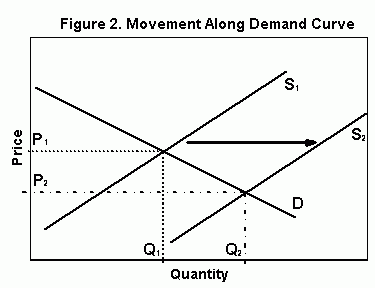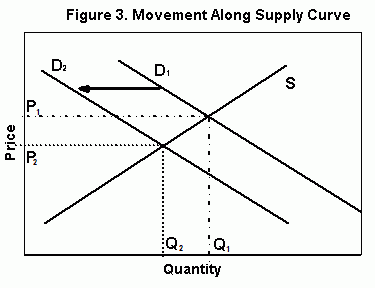Introduction
Price is dependent on the interaction between demand and supply components of a market. Demand and supply represent the willingness of consumers and producers to engage in buying and selling. An exchange of a product takes place when buyers and sellers can agree upon a price.
This section of the Agriculture Marketing Manual explains price in a competitive market. When imperfect competition exists, such as with a monopoly or single selling firm, price outcomes may not follow the same general rules.
Equilibrium price
When a product exchange occurs, the agreed upon price is called an equilibrium price, or a market clearing price. Graphically, this price occurs at the intersection of demand and supply as presented in Image 1.
In Image 1, both buyers and sellers are willing to exchange the quantity Q at the price P. At this point, supply and demand are in balance. Price determination depends equally on demand and supply.
Image 1. Figure 1, Graph showing price equilibrium curves

It is truly a balance of the market components. To understand why the balance must occur, examine what happens when there is no balance, such as when market price is below that shown as P in Image 1.
At any price below P, the quantity demanded is greater than the quantity supplied. In such a situation, consumers would clamour for a product that producers would not be willing to supply; a shortage would exist. In this event, consumers would choose to pay a higher price in order to get the product they want, while producers would be encouraged by a higher price to bring more of the product onto the market.
The end result is a rise in price, to P, where supply and demand are in balance. Similarly, if a price above P were chosen arbitrarily, the market would be in surplus with too much supply relative to demand. If that were to happen, producers would be willing to take a lower price in order to sell, and consumers would be induced by lower prices to increase their purchases. Only when the price falls would balance be restored.
A market price is not necessarily a fair price, it is merely an outcome. It does not guarantee total satisfaction on the part of buyer and seller. Typically, some assumptions about the behaviour of buyers and sellers are made, which add a sense of reason to a market price. For example, buyers are expected to be self-interested and, although they may not have perfect knowledge, at least they will try to look out for their own interests. Meanwhile, sellers are considered to be profit maximizers. This assumption limits their willingness to sell to within a price range, high to low, where they can stay in business.
Change in equilibrium price
When either demand or supply shifts, the equilibrium price will change. The section on understanding supply factors explains why a market component may move. The examples below show what happens to price when supply or demand shifts occur.
Example 1: Unusually good weather increases output
When a bumper crop develops, supply shifts outward and downward, shown as S2 in Image 2, more product is available over the full range of prices. With no immediate change in consumers' willingness to buy crops, there is a movement along the demand curve to a new equilibrium. Consumers will buy more but only at a lower price. How much the price must fall to induce consumers to purchase the greater supply depends upon the elasticity of demand.
Image 2. Figure 2, Graph showing movement along demand curve

In Image 2, price falls from P1 to P2 if a bumper crop is produced. If the demand curve in this example was more vertical (more inelastic), the price-quantity adjustments needed to bring about a new equilibrium between demand and the new supply would be different.
To understand how elasticity of demand affects the size of adjustment in prices and quantities when supply shifts, try drawing the demand curve (or line) with a slope more vertical than that depicted in Image 2. Then compare the size of price-quantity changes in this with the first situation. With the same shift in supply, equilibrium change in price is larger when demand is inelastic than when demand is more elastic.
The opposite is true for quantity. A larger change in quantity will occur when demand is elastic compared with the quantity change required when demand is inelastic.
Example 2: Consumers lower their preference for beef
A decline in the preference for beef is one of the factors that could shift the demand curve inward or to the left, as seen in Image 3.
Image 3. Figure 3. Graph showing movement along supply curve

With no immediate change in supply, the effect on price comes from a movement along the supply curve. An inward shift of demand causes price to fall and also the quantity exchanged to fall. The amount of change in price and quantity, from one equilibrium to another, is dependent upon the elasticity of supply.
Imagine that supply is almost fixed over the time period being considered. That is, draw a more vertical supply curve for this shift in demand. When demand shifts from D1 to D2 on a more vertical supply curve (inelastic supply) almost all the adjustment to a new equilibrium takes place in the change in price.
Price stability
Two forces contribute to the size of a price change: the amount of the shift and the elasticity of demand or supply. For example, a large shift of the supply curve can have a relatively small effect on price if the corresponding demand curve is elastic. That would show up in Example 1 above, if the demand curve is drawn flatter (more elastic).
In fact, the elasticity of demand and supply for many agricultural products are relatively small when compared with those of many industrial products. This inelasticity of demand has led to problems of price instability in agriculture when either supply or demand shifts in the short-term.
Price level
The two examples above focus on factors that shift supply or demand in the short-term. However, longer-term forces are also at work, which shift demand and supply over time. One particular supply shifter is technology. A major effect of technology in agriculture has been to shift the supply curve rapidly outward by reducing the costs of production per unit of output.
Technology has had a depressing effect on agricultural prices in the long-term since producers are able to produce more at a lower cost. At the same time, both population and income have been advancing, which both tend to shift demand to the right. The net effect is complex, but overall the rapidly shifting supply curve coupled with a slow moving demand has contributed to low prices in agriculture compared to prices for industrial products.
At various levels of a market, from farm gate to retail, unique supply and demand relationships are likely to exist. However, prices at different market levels will bear some relationship to each other. For example, if hog prices decline, it can be expected that retail pork prices will decline as well. This price adjustment is more likely to happen in the long-term once all participants have had time to adjust their behaviour.
In the short-term, price adjustments may not occur for a variety of reasons. For example, wholesalers may have long-term contracts that specify the old hog price, or retailers may have advertised or planned a feature to attract customers.
Summary
Market prices are dependent upon the interaction of demand and supply.
An equilibrium price is a balance of demand and supply factors.
There is a tendency for prices to return to this equilibrium unless some characteristics of demand or supply change.
Changes in the equilibrium price occur when either demand or supply, or both, shift or move.